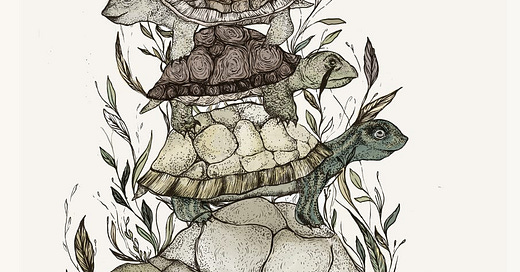The story is told of an encounter between William James, one of the founders of modern psychology, and a little old lady who attended one of his cosmology lectures. The conversation, as reported on Wikipedia, went like this:
"Your theory that the sun is the center of the solar system, and the earth is a ball which rotates around it has a very convincing ring to it, Mr. James, but it's wrong. I've got a better theory," said the little old lady.
"And what is that, madam?" inquired James politely.
"That we live on a crust of earth which is on the back of a giant turtle."
"If your theory is correct, madam," he asked, "what does this turtle stand on?"
"You're a very clever man, Mr. James, and that's a very good question," replied the little old lady, "but I have an answer to it. And it's this: The first turtle stands on the back of a second, far larger, turtle, who stands directly under him."
"But what does this second turtle stand on?" persisted James patiently.
To this, the little old lady crowed triumphantly,
"It's no use, Mr. James—it's turtles all the way down."
About ten years ago, I too had a “turtles all the way down” epiphany. It happened while studying genetics and molecular biology. In my case, the revelation was that words lie at the heart of all living things, not just stories. The living world, in other words, rests on words, not turtles. And it’s words all the way down!
So, what exactly do I mean when I say, “Words all the way down?” To answer that question, let’s start at the bottom, with genetics. Most of us already know the story of Watson and Crick’s 1953 discovery that DNA is a double helix, composed of two strands twisted together. Each strand is a series of connected nucleotides, linked together like pearls on a necklace. Except, in this case, DNA has four different kinds of nucleotides (pearls) – adenine (A), cytosine (C), thymine (T), and guanine (G). I list the letters after each name because these are, in a real sense, the letters of life’s alphabet. And yes, there’s one final letter, uracil (U). In RNA, U takes the place of thymine (T). Life apparently likes a little variety.
The two DNA strands complement each other. That is, A always pairs with T and C always pairs with G. The building blocks of life snap together in one way and one way only. Here’s a picture of the DNA molecule:
Image: https://theory.labster.com/dna-structure/
Now that we’ve identified the letters, let’s talk about the words. In molecular biology, these are called codons. During transcription, a part of the DNA strand is gently pulled apart by RNAPolymerase, a molecular machine that synthesizes RNA. RNA is therefore a transcript of DNA, a mirror image of a discrete strand of nucleotides. If the DNA sequence is CGTA, then its RNA sequence complement is GCAT. After an RNA strand exits the cell’s nucleus, it’s then read by a Ribosome, three letters at a time. This is where it gets interesting! Each three letter codon (word) stands for an amino acid or punctuation mark. Yes, the textbook of life has punctuation as we will see in the next paragraph.
As noted earlier, all codons are three letters long. But why is that? To answer that question, we need to review some basic ideas from molecular biology. The first is the fact that the physical building blocks of life are proteins, and the proteins found in all living organisms are constructed using just 20 amino acids. More concretely, a protein is simply a string of amino acids linked together and folded into a specific shape. In the image below, we see a ribosome synthesizing a protein. At the top, a growing chain of amino acids exits the large subunit. As the Ribosome pulls an RNA strand through it, transfer RNA (tRNA) anticodons match to complementary codons in the messenger RNA (mRNA) sequence. At the moment of codon recognition, the tRNA attaches an amino acid to the protein sequence. This iterative process continues until the Ribosome encounters a stop codon, a period that marks the end of a chemical sentence. The final product is a string of amino acids that then fold into a protein.
Now back to our original question. Why are codons 3-letters long? The answer is that we need at least three letters to uniquely specify the 20 amino acids! The table below shows the genetic code, a dictionary of sorts that tells us what each 3-letter codon means; that is, the amino acid it stands for. The amino acids are not fully written out but abbreviated using three letters. Tyr, for example, is tyrosine. Lys is lysine. Ala is alanine, and so on.
Image: https://oertx.highered.texas.gov/courseware/lesson/1682/overview
So what does this all mean? The thought that all living things rest on a foundation of words (codons) is revolutionary. It means that life is hermeneutical, hermeneutics being the study of how we derive meaning from texts. For hundreds of years – at least since the Renaissance – the humanities have focused almost exclusively on the reading of texts and their interpretation. If, however, hermeneutics lies at the heart of the life sciences too, then we might be able to achieve a grand synthesis, a single starting point for the humanities, the life sciences, and artificial intelligence.
In future posts, I’ll explore this idea further, the thought that words and stories are fundamental to all living things. Hopefully, this will expand our horizons in a way that helps us more fully appreciate the power of story.








Eager to read more. That is a shaking (and exhilarating) realization, that words are at the base of life.
Thank you for the explanation of codons. Mmmm, helpful.